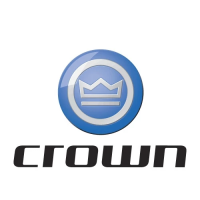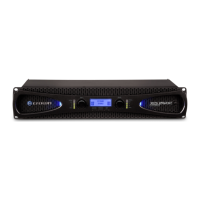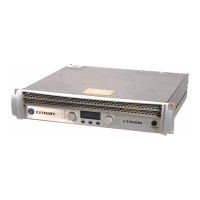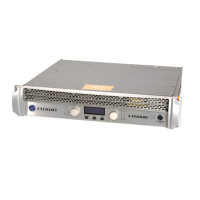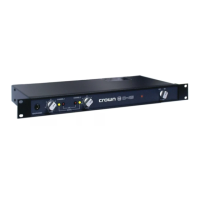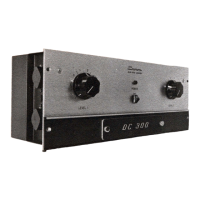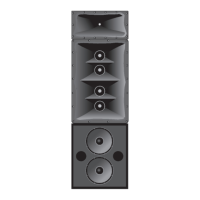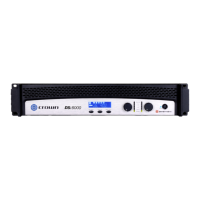I-Tech HD DriveCore Series Power Ampliers
Operation Manual
page 27
7.3.3 Downloadable Presets
Crown and JBL engineers have designed I-Tech HD DSP presets that are
opti mized for various JBL loudspeakers, such as VerTec Line Arrays. To use
them, follow this procedure in System Architect:
Go to www.jblpro.com.
Section 7.8.19 describes the Presets Manager screen in System Architect.
7.3.4 Loading I-Tech HD 2 Channel Presets Into the
I-Tech HD 4 Channel
In System Architect, double click on HD4. Go to File › Open Preset, find a 2
Channel ITHD preset by selecting 2 Channel Preset from file “file of type” drop
down menu. Open the Preset from the and S2 will present options to load it into
Channels 1/2 or 3/4.
7.4 File Transfer Via the USB Port
On the front panel of the amplifier is a USB Type A port which can transfer files
either direction between a USB flash drive and the amplifier. These files can be
of three types:
A Preset file, which contains amplifier DSP settings for a specific
loudspeaker/amplifier configuration.
A Device file, which contain all 50 presets and the current amplifier DSP
settings.
A Firmware file.
When you plug in the drive, the amplfier defaults to a file-exchange mode (and
is muted). Then you can load or save individual files. No computer is needed
for this file transfer.
7 Advanced Operation
7.3 Presets
7.3.1 Introduction
Your I-Tech HD amplifier has a wide variety of onboard Digital Signal
Process ing (DSP). Some applications for this DSP are speaker configuration
(set ting the drive levels, frequency bands, delays and limiting for your
particular speakers), EQ, filtering, compression, and much more. System
Architect software lets you adjust the DSP settings, such as filter slope,
compression ratio, EQ frequency bands, and so on.
A preset is a group of DSP settings that configure the amp for a specific
application. For example, you might use one preset that optimizes the amp’s
DSP for a JBL VerTec Line Array. You might use another preset that sets up the
DSP for a stereo pair of loudspeakers of your choice. You can choose any of
50 presets with the LCD Control Screen.
Preset 1 is the factory default preset and cannot be overwritten. It sets up the
amplifier for stereo operation with no DSP features enabled.
The I-Tech HD amplifier works with two types of presets:
1. User presets. Using System Architect, you can create your own custom
DSP presets, label them, and send them to the I-Tech HD ampli fier. The amp
stores those presets in firmware. You can recall those presets from the LCD
Control Screen.
2. Downloadable presets. Crown and JBL engineers have designed
presets that are optimized for various JBL loudspeakers, such as VerTec Line
Arrays. You can download presets from www.jblpro.com. Then in the software,
or with a USB drive, send the preset files to the I-Tech HD amplifier, where you
can recall them from the LCD Control Screen.
We will describe each type of preset in detail.
7.3.2 User Presets
User presets are DSP presets that are configured manually.
This is the basic procedure:
1. Adjust the DSP settings as desired in the System Architect soft ware (not
with the LCD Control Screen).
2. Save this group of settings as preset. Give it a label.
3. Download the preset to the I-Tech HD amplifier. See the software Help file
for details. As soon as you save the setting as a preset, it is sent to the
amplifier. Another option, described on the next page, is to transfer the
preset file using a USB drive.
4. Select that preset from the LCD Control Screen. The preset will
automat ically set the DSP parameters as you set them up in the control
software.
Setting some parameters of the DSP in the I-Tech HD amplifier is done using
the control software, not by the amplifier’s LCD Control Screen. For example,
if you want to set filter Q, compression ratio, or graphic EQ, you would do so
within the System Architect software.
5. When you want to recall the preset, select it from the Preset screen in the
LCD display. The preset will automat ically set the DSP parameters as you set
them up in the control software.
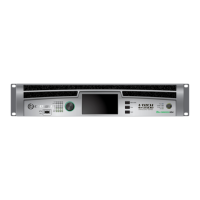
